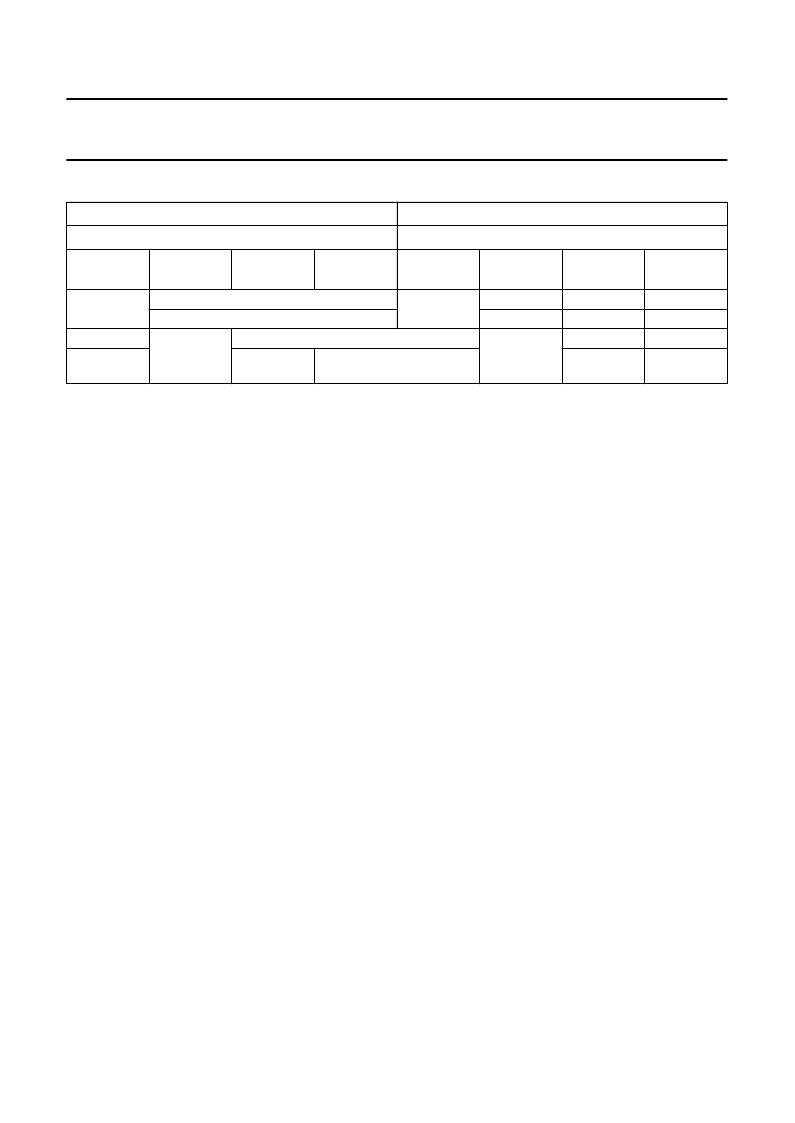- 您現(xiàn)在的位置:買賣IC網(wǎng) > PDF目錄372108 > SAA2500H (NXP SEMICONDUCTORS) MPEG Audio Source Decoder PDF資料下載
參數(shù)資料
| 型號: | SAA2500H |
| 廠商: | NXP SEMICONDUCTORS |
| 元件分類: | 消費(fèi)家電 |
| 英文描述: | MPEG Audio Source Decoder |
| 中文描述: | SPECIALTY CONSUMER CIRCUIT, PQFP44 |
| 封裝: | 10 X 10 MM, 1.75 MM HEIGHT, PLASTIC, SOT-307-2, QFP-44 |
| 文件頁數(shù): | 25/47頁 |
| 文件大?。?/td> | 199K |
| 代理商: | SAA2500H |
第1頁第2頁第3頁第4頁第5頁第6頁第7頁第8頁第9頁第10頁第11頁第12頁第13頁第14頁第15頁第16頁第17頁第18頁第19頁第20頁第21頁第22頁第23頁第24頁當(dāng)前第25頁第26頁第27頁第28頁第29頁第30頁第31頁第32頁第33頁第34頁第35頁第36頁第37頁第38頁第39頁第40頁第41頁第42頁第43頁第44頁第45頁第46頁第47頁

September 1994
25
Philips Semiconductors
Preliminary specification
MPEG Audio Source Decoder
SAA2500
Table 19
Validity of SAA2500 readable data items with respect to the decoding subprocess (notes 1 and 2).
Notes
1.
The Table shows following:
a) The received Ancillary Data that was multiplexed in frame n
1 becomes valid after subprocess 0 of frame n, and
may be read during subprocesses 1, 2 and 3 of frame n.
b) The decoded and used frame headers for frame n become valid after subprocess 0 of frame n, and may be read
during subprocesses 1, 2 and 3 of frame n.
c) Flag BALOK for frame n in the error report item becomes valid after subprocess 1 of frame n, and may be read
during subprocesses 2 and 3 of frame n and subprocess 0 of frame n+1.
d) Flag DECFM for frame n in the error report item becomes valid after subprocess 2 of frame n, and may be read
during subprocesses 3 of frame n and 0 of frame n+1.
Note that during subprocess 3 all data items can be read.
2.
SAA2500 IS DECODING FRAME n
SAA2500 IS DECODING FRAME n + 1
DST2 = 0
DST2 = 1
DST1 AND
DST0 = 0
DST1 AND
DST0 = 1
Ancillary Data item (frame n
1)
frame header items (frame n)
not valid
error report: BALOK (frame n)
not valid
DST1 AND
DST0 = 2
DST1 AND
DST0 = 3
DST1 AND
DST0 = 0
DST1 AND
DST0 = 1
not valid
DST1 AND
DST0 = 2
not valid
DST1 AND
DST0 = 3
not valid
not valid
error report: DECFM
(frame n)
D
ATA ITEMS
Data can be transferred to or from the SAA2500 in data
items. This section describes the general protocol to
accomplish item data transfer, followed by the individual
SAA2500 data items. Optional enhancements on the
general protocol are described in Chapter “Appendix”
Section “SAA2500 L3 protocol enhancement options”.
General data items
The data items of the SAA2500 are transferred (i.e. read
or written, depending on whether the data item is of
readable or writeable type) in bytes. A data item transfer is
initiated by writing the corresponding type I control byte
(see Section “L3 interface control”) to the SAA2500. The
transfer of every subsequent item data byte must be
preceded by reading the status until status flag L3RDY
(see Section “SAA2500 status”) is HIGH.
L3RDY may be tested alternatively by polling L3DATA,
avoiding the need to transfer the whole status byte. Status
polling is not required while transferring the APU
coefficients item. Table 20 shows an example of how
bytes ‘DDDDDDDD’ of a 2 byte data item, with the
corresponding control byte ‘CCCCCCCC’, can be read.
The writing of item data bytes occurs in a similar way.
相關(guān)PDF資料 |
PDF描述 |
|---|---|
| SAA2501 | Digital Audio Broadcast DAB decoder |
| SAA2501H | Digital Audio Broadcast DAB decoder |
| SAA2502 | ISO/MPEG Audio Source Decoder |
| SAA2502H | ISO/MPEG Audio Source Decoder |
| SAA2503 | MPEG2 audio decoder(MPEG2 音頻譯碼器) |
相關(guān)代理商/技術(shù)參數(shù) |
參數(shù)描述 |
|---|---|
| SAA2500HB-S | 制造商:未知廠家 制造商全稱:未知廠家 功能描述:Video Processing/ENDEC for MPEG |
| SAA2501 | 制造商:PHILIPS 制造商全稱:NXP Semiconductors 功能描述:Digital Audio Broadcast DAB decoder |
| SAA2501H | 制造商:PHILIPS 制造商全稱:NXP Semiconductors 功能描述:Digital Audio Broadcast DAB decoder |
| SAA2501HB-S | 制造商:未知廠家 制造商全稱:未知廠家 功能描述:Digital Audio Decoder & Support |
| SAA2502 | 制造商:PHILIPS 制造商全稱:NXP Semiconductors 功能描述:ISO/MPEG Audio Source Decoder |
發(fā)布緊急采購,3分鐘左右您將得到回復(fù)。